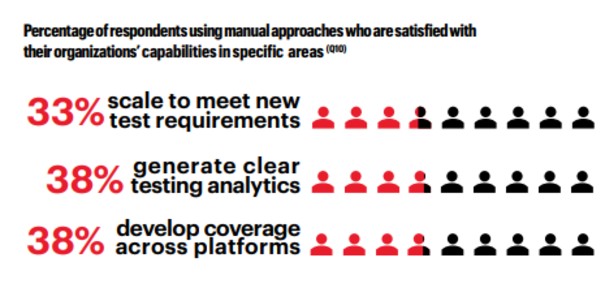Digital transformation in the healthcare sector has accelerated in recent years, driven by the global pandemic and increased virtual connectivity. As healthcare organizations aim to harness the value of modern technologies such as virtual care, data analytics, and artificial intelligence, they also confront the critical necessity of robust software testing strategies.
Author: Emily Yan, Industry Marketing Manager at Keysight Technologies
The Healthcare Information and Management Systems Society (HIMSS) recently conducted a study titled “Vital Signs”, revealing the testing challenges faced by healthcare IT leaders and the inadequate scalability of manual testing in the sector. With the complexity and customization of electronic medical records (EMR) systems increasing, automated testing methods become more than just a luxury – they are a must for patient safety.
Manual Testing: A Slowing Horse in a Fast-paced Race
While automation has seen wide adoption in various industries, the healthcare sector significantly lags behind, with 41% of healthcare providers still relying on manual testing methods. This poses significant challenges as electronic medical records (EMR) systems become increasingly complex and customized. In fact, only 6% of executive leaders surveyed expressed confidence that they were testing enough to minimize patient risk.
The study discloses that only 15% of healthcare providers have adopted modern test automation platforms, highlighting the urgency for increased automation in testing. With manual testing’s scalability issues becoming more evident, only a third of manual testers reported satisfaction with their organizations’ capacity to scale testing to meet new requirements. Even fewer were satisfied with the availability of clear testing analytics and the ability to develop test coverage across all devices and browsers.

Figure 1. Percentage of respondents using manual approaches who are satisfied with their organizations’ capabilities in specific areas
Do-It-Yourself Testing: A Path Fraught with Challenges
In the quest to overcome the limitations of manual testing, healthcare organizations have considered an alternative approach — do-it-yourself (DIY) testing. At face value, the DIY approach may seem to provide a solution, a fact reflected in the study as over 40% of healthcare organizations were considering this option. However, the DIY testing approach is not without its pitfalls, which often go unseen until organizations are well down the path.
The first and foremost challenge is the need for a robust in-house technical talent pool. Modern healthcare applications and compliance requirements demand specialized expertise in several fields, such as programming, test automation, and requirements testing. For many organizations, especially smaller ones or those in under-resourced regions, sourcing and retaining this kind of talent can be an insurmountable hurdle.
Furthermore, the hidden costs associated with the DIY testing approach often only become apparent after an organization has committed to this path. These costs can include the recruitment of specialized personnel, infrastructural investments, ongoing training to keep up with evolving technologies and regulations, and the procurement and maintenance of the necessary hardware and software tools. These hidden costs often exceed initial budgets, creating financial strain and placing additional stress on healthcare organizations.
Resilience through Automating Healthcare Software Testing
Recognizing these formidable challenges, the study highlights the vast potential of machine learning (ML) algorithms to bolster the capacity and capabilities of software testing teams. ML-powered testing tools can analyze historical data patterns, prioritize test cases, and automatically generate critical tests for various platforms, devices, and operating systems. This exciting synergy between human expertise and machine learning capabilities can pave the way for healthcare organizations to increase the productivity of their quality assurance (QA) teams and achieve more comprehensive testing coverage within the stringent timelines often faced in the healthcare sector.
Encouragingly, the study reveals a positive future trend in this regard — a significant 75% of healthcare providers are projected to adopt test automation within the next five years. Early adopters have already reported notable benefits from embracing test automation, including improved resilience to future challenges and higher satisfaction rates in their ability to scale testing to meet emerging requirements.
Conclusion
We are ushering in an era where healthcare software testing will predominantly be automated. Those healthcare organizations that adapt to this changing landscape early are likely to reap the most benefits. However, as they venture into the realm of automation, these organizations must stay informed about evolving healthcare testing requirements. They must also critically evaluate potential automation vendors against crucial regulatory standards to ensure that patient safety remains at the forefront of all technological advancements.
A technology-agnostic solution that ensures comprehensive test coverage across all platforms can significantly boost efficiency. Providing QA teams with user-friendly test automation tools can also streamline the onboarding and collaboration processes, allowing testers to focus their expertise on strategic initiatives.
In the end, by embracing automation and harnessing the power of machine learning, healthcare providers can overcome the limitations of manual testing. This enables them to enhance testing coverage and, most importantly, protect and improve patient well-being in an increasingly digital healthcare landscape.
About the Author
Author Bio: Emily Yan is a Product Marketing Manager at Keysight Technologies. She leads the healthcare campaign for Keysights’s software test automation. Before joining Keysight, Emily had worked in EDA marketing and corporate communications at Synopsys for four years and managed digital media at Fivetran, a data integration startup. Emily holds an MPA degree from Columbia University and dual Bachelor’s degrees in math and economics from UC Berkeley. (LinkedIn)
About Keysight Technologies
At Keysight (NYSE: KEYS), we inspire and empower innovators to bring world-changing technologies to life. As an S&P 500 company, we’re delivering market-leading design, emulation, and test solutions to help engineers develop and deploy faster, with less risk, throughout the entire product lifecycle. We’re a global innovation partner enabling customers in communications, industrial automation, aerospace and defense, automotive, semiconductor, and general electronics markets to accelerate innovation to connect and secure the world. Learn more at Keysight Newsroom and www.keysight.com.

